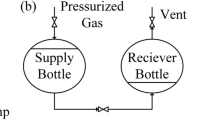Abstract
An ammonia self-managed vaporization propulsion (ASVP) system for micro-nano satellites is presented. Compared with a normal cold gas or liquefied gas propulsion system, a multiplex parallel sieve type vaporizer and related vaporization control methods are put forward to achieve self-managed vaporization of liquefied propellant. The problems of high vaporization latent heat and incomplete vaporization of liquefied ammonia are solved, so that the ASVP system takes great advantage of high theoretical specific impulse and high propellant storage density. Furthermore, the ASVP operation procedure and its physical chemistry theories and mathematical models are thoroughly analyzed. An optimal strategy of thrust control is proposed with consideration of thrust performance and energy efficiency. The ground tests indicate that the ASVP system weighs 1.8 kg (with 0.34-kg liquefied ammonia propellant) and reaches a specific impulse of more than 100 s, while the power consumption is less than 10 W. The ASVP system meets multiple requirements including high specific impulse, low power consumption, easy fabrication, and uniform adjustable thrust output, and thus is suitable for micro-nano satellites.
Similar content being viewed by others
References
Carpenter CB, Schmuland D, Overly J, et al., 2013. Cube-Sat high-impulse adaptable modular propulsion system (CHAMPS) product line development status and mission applications. Proc 45th AIAA/ASME/SAE/ASEE Joint Propulsion Conf, p.1-16. https://doi.org/10.2514/6.2013-3760
Chigier N, Gemci T, 2003. A review of micro propulsion technology. Proc 41st Aerospace Sciences Meeting and Exhibit, p.1-11. https://doi.org/10.2514/6.2003-670
Fu XC, Shen WH, Yao TY, et al., 2005. Phase equilibrium. In: Fu XC, Shen WX, Tao TY, et al. (Eds.), Physical Chemistry (5th Ed.). Higher Education Press, Beijing, China, p.270–280 (in Chinese).
Gibbon D, Charman P, Kay N, 2000. The design, development and in-orbit performance of a propulsion system for the SNAP-1 nanosatellite. Proc 3rd Int Conf on Spacecraft Propulsion, p.91-98.
Gibbon D, Paul M, Smith P, et al., 2001. The use of liquefied gases in small satellite propulsion systems. Proc 37th Joint Propulsion Conf and Exhibit, p.1-7. https://doi.org/10.2514/6.2001-3246
Guo SQ, Hou H, Zhang Y, 2013. Propulsion subsystem technology for YH-1 Mars probe. Aerosp Shanghai, 30(4):96–99, 245 (in Chinese). https://doi.org/10.3969/j.issn.1006-1630.2013.04.019
Hejmanowski NJCA, Woodruff RB, 2015. CubeSat high impulse propulsion system (CHIPS). Proc 62nd JANNAF Propulsion Meeting (7th Spacecraft Propulsion), p.1-12.
Lappas V, Pottinger S, Knoll A, et al., 2011. Micro-electric propulsion (EP) solutions for small satellite missions. Proc 2nd Int Conf on Space Technology, p.1-4. https://doi.org/10.1109/icspt.2011.6064668
Lemmer K, 2017. Propulsion for CubeSats. Acta Astronaut, 134:231–243. https://doi.org/10.1016/j.actaastro.2017.01.048
Levchenko L, Bazaka K, Ding YJ, et al., 2018. Space micropropulsion systems for CubeSats and small satellites: from proximate targets to furthermost frontiers. Appl Phys Rev, 5:011104. https://doi.org/10.1063/1.5007734
Matticari G, Noci GE, Siciliano P, et al., 2006. Cold gas micro propulsion prototype for very fine spacecraft attitude/position control. Proc 42nd AIAA/ASME/SAE/ASEE Joint Propulsion Conf, p.1-13. https://doi.org/10.2514/6.2006-4872
Poghosyan A, Golkar A, 2017. CubeSat evolution: analyzing CubeSat capabilities for conducting science missions. Prog Aerosp Sci, 88:59–83. https://doi.org/10.1016/j.paerosci.2016.11.002
Ranjan R, Chou SK, Riaz F, et al., 2017. Cold gas micro propulsion development for satellite application. Energy Proc, 143:754–761. https://doi.org/10.1016/j.egypro.2017.12.758
Robin MR, Brogan TR, Cardiff EH, 2008. An ammonia microresistojet (MRJ) for micro satellites. Proc 44th AIAA/ASME/SAE/ASEE Joint Propulsion Conf and Exhibit, p.1-11. https://doi.org/10.2514/6.2008-5288
Satellite Industry Association, 2017. 2017 State of the Satellite Industry Report. Satellite Industry Association, p.18-22. http://www.sia.org [Accessed on Feb. 23, 2017].
Scharfe DB, Ketsdever AD, 2009. A review of high thrust, high delta-V options for microsatellite missions. Proc 45th AIAA/ASME/SAE/ASEE Joint Propulsion Conf and Exhibit, p.1-14. https://doi.org/10.2514/6.2009-4824
Tang HB, Liu C, Xiang M, et al., 2007. Full elastic microthrust measurement equipment. J Propul Technol, 28(6):703–706 (in Chinese). https://doi.org/10.13675/j.cnki.tjjs.2007.06.023
Wei Q, Li YC, 2012. Technology of ammonia flashing jet propulsion in BX-1 satellite. Manned Spacefl, 18(1):86–91 (in Chinese). https://doi.org/10.3969/j.issn.1674-5825.2012.01.016
Wu XS, Chen J, Wang D, 2016. Foundation of one demensional steady flow. In: Wu XS, Chen J, Wang D (Eds.), Gas Dynamics of Solid Propellant Rocket Motor. Beihang University Press, Beijing, p.32–58 (in Chinese).
Zube DM, Messerschmid EW, 1993. ATOS-flight experiment for a 700W ammonia arcjet. Proc 29th AIAA/ASME/SAE/ASEE Joint Propulsion Conf and Exhibit, p.1-13. https://doi.org/10.2514/6.1993-2224
Author information
Authors and Affiliations
Corresponding author
Ethics declarations
Shu-jian SUN, Tao MENG, and Zhong-he JIN declare that they have no conflict of interest.
Additional information
Project supported by the National Natural Science Foundation of China (No. 61503334) and the National Science Fund for Distinguished Young Scholars (No. 61525403)
Rights and permissions
About this article
Cite this article
Sun, Sj., Meng, T. & Jin, Zh. Design, development, and performance of an ammonia self-managed vaporization propulsion system for micro-nano satellites. Front Inform Technol Electron Eng 20, 1516–1529 (2019). https://doi.org/10.1631/FITEE.1800068
Received:
Revised:
Published:
Issue Date:
DOI: https://doi.org/10.1631/FITEE.1800068
Key words
- Self-managed vaporization
- Liquefied ammonia
- Milli-Newton level propulsion
- Micro-thrust
- High-precision orbital control
- Micro-nano satellite




